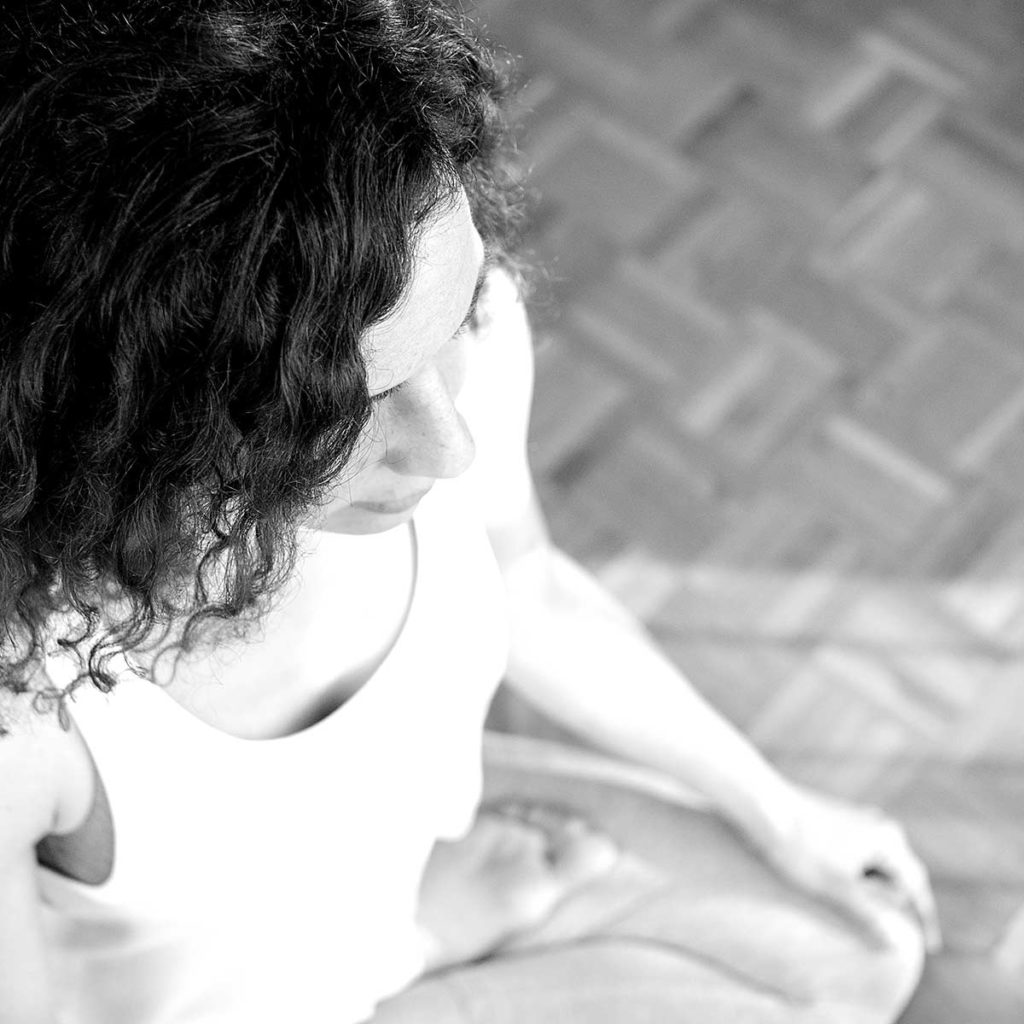Antar Mauna is a powerful form of meditation made famous by the Indian yoga master Swami Satyananda. It consists of several distinct techniques that you practise in a sequence. Each step trains your mind differently. The meditation helps you undo identifying with your mind’s content and instead connect with the peaceful silence underlying all thoughts.
This article will teach you all you need to know about the Antar Mauna meditation, including how to practise it by yourself.
Origins of the Inner Silence meditation
Antar Mauna is Sanskrit and means Inner Silence. It is allegedly an ancient tantric practice that Swami Satyananda, founder of the Bihar School of Yoga, picked up as he travelled throughout India searching for wisdom. He recognised its value and made it a core practice in his tradition.
The name Inner Silence is not an advertisement for thoughtlessness. Instead, it refers to the witnessing awareness, the empty medium in which all experiences play out.
You will also see Antar Mauna spelt “Antar Mouna”. That is because there are different ways to represent Sanskrit letters with Latin characters.
How Antar Mauna is different from other meditations
The Antar Mauna meditation builds on the same principles as other classical meditations such as Zen, Vipassana and Maha Mudra. However, there is one fundamental difference. Inner Silence is a multi-step practice. That means that you engage in different types of methods in a well-defined order. Each step has its effect, but furthermore, it prepares you for the next one. Hence, you can gradually calm your mind and fluidly move to more and more complex practices.
The step by step way of practising is derived from tantric rituals. It is a typical trait of Satyananda Yoga.
In official publications by the Bihar School of Yoga, Antar Mauna has five or six steps. But when my teacher, Swami Janakananda, learned it directly from Satyananda in the sixties, he was taught seven. It is the seven-step sequence that I am going to describe.
Benefits of Inner Silence
The ultimate benefit of Inner Silence is that it helps you connect with awareness. Some talk about awareness as a witness. At first, the meditation teaches you to see thoughts, ideas, moods and states for what they are rather than as a part of who you are. When you no longer identify with your thoughts, your mind becomes transparent and spacious.
Then, you begin to realise that the sheer act of experiencing is a crucial part of existing. Passive awareness becomes more and more tangible. It shines forth as the only constant in life. Once you have this realisation, you have something tremendously valuable to hold on to. Even if the knowledge is vague and difficult to express, the safety it gives you will carry you through life.
In addition, along with the main goal of the practice, there are many benefits on a more down to earth plane. For example, you develop the ability to live life’s big and small ups and downs with equanimity. Antar Mauna also increases concentration, vigilance and cognitive control. Furthermore, you improve your ability to channel your energy, develop your willpower, and become better at stopping unnecessary thinking.
The different steps of the meditation have distinct effects. Later on, we will look at how they each train your mind differently.

Instructions for Antar Mauna
I will now describe precisely how to practice the Inners Silence meditation. I will give you complete instructions for each step. These instructions come from transcripts of meditations that I guide here on Forceful Tranquility.
Don’t be in a hurry to start
How you get into your meditation has an impact on your whole experience in sitting. So don’t be in a hurry when you start. Instead, take some time to sit with your eyes open, look around for a minute. Appreciate the place in which you find yourself. Even when you have closed your eyes, keep sitting for another minute and don’t do anything in particular.
Also, as you tune in for the meditation, drop your expectations and ambitions. You are better off going into your practice open-minded, taking things as they come.
Step one – All around awareness of sounds
In this step, you practice being aware of sounds around you without focusing.
Example instructions
Sit motionless with your eyes closed and become aware of the sounds that you can hear. Receive all sound vibrations from all directions. Notice them without focusing on any particular one.
Keep up this overall awareness of sounds.
There may be soft sounds; there may be loud sounds. Maybe many sounds, perhaps few. Notice all the sounds that you hear, no more, no less. Be present in the soundscape.
If it is quiet where you are, that is fine too. Then hear the silence and the few sounds that break the silence. If you are in a very calm place, you might want to bring in your other senses and feel the air against your skin, clothes, air temperature, and even scents. Incorporate all sense impressions into your experience of sounds.
Stay with the soundscape without getting caught up in any specific sound. Keep an overall awareness. Hear the sounds like you would hear music.
Benefits of the first step
Heightened vigilance
By spreading your awareness and by always staying observant of any sound, you train your vigilance. Vigilance is the capacity to maintain attention over time.
Pratyahara
Pratyahara is the withdrawal of the senses. When you take time at the beginning of your meditation to fully experience sounds and other sense impressions, you will develop a relaxed relationship with these impressions. As a result, they will not disturb you as you progress with the next steps.
Heightened sensory perception
By perceiving the sounds deliberately, you will fine-tune your hearing and notice more and more subtle sounds.

Step two – Awareness of spontaneous thoughts
In the second step of Antar Mauna, you will practice your capacity to be open to any experience without controlling your attention. I prefer to call this practice “open awareness”.
Example instructions
Without controlling your attention, notice everything that arises in your mind. Or any external impressions for that matter. Just observe anything that comes into your sphere of awareness as a quiet witness.
Let your thoughts do as they please. Just as you allow your breath to flow freely, allow your mind to do the same. Observe the flow of mental and emotional activity, the flow of mind.
You could experience echoes from what you have been doing earlier today. You might think thoughts that relate to the meditation, to what you are doing or to yourself. All thoughts are part of this experience. Allow all thoughts to arise.
Observe your mind without judgement. Welcome everything. Even thoughts that you usually consider disturbing or unpleasant are welcome. Don’t fall into the trap of seeking peace and of pushing discomfort away. Stay neutral, stay the silent witness.
Benefits of the second step
Mindfulness
Open awareness is mindfulness meditation in its ultimate form.
What is mindfulness precisely? Here below is how the famous scientific journalist Daniel Goleman defines it.
“Mindfulness, as it’s taught in the classic traditions, encourages us to take an equanimous position amidst the coming and going of our own feelings and thoughts. And to see them as feelings and thoughts rather than “that’s me”, and to just note them without judgment or without reactivity and to let them come and go.”
That is precisely the attitude you adopt in Antar Mauna’s second step. And by doing it, you become better at it. With enough practice it becomes a spontaneous attitude, not only while you are meditating but in any situation.
The position of the witness and meta-awareness
Seeing the coming and going of thoughts makes you connect to the inner witness. Your attitude is that you are not your thoughts; you are not that which you observe. You are the observer or even the observation. Being conscious of where your attention goes is what scientists call meta-awareness, awareness of awareness.
Accelerated mental digestion
Letting your mind have its way makes it flow naturally. When your mind flows unhindered, it is excellent at taking care of any mental tensions that life gives you. Accumulated experiences that you have not yet had the chance to digest will surface, and the light of your awareness will burn the tensions that were bound. It’s natural mental housekeeping similar to what happens when you dream.
Becoming familiar with thought patterns
By observing your mind during the Inner Silence meditation, you get to know it. Which means that you learn what kind of reactions some thoughts trigger and what makes you get and stay involved. Furthermore, you learn to recognise chains of ideas and loops of thoughts.

Step three – Creation of thoughts and stopping them
In this step, you first choose something to think about, and then you stay with your mental task, without letting your attention slip away. After some time you drop the thought and don’t think of anything.
I typically guide my students to repeat the process two to three times. Staying with one thought for a couple of minutes is sufficient.
Below you will find some mental tasks that I find particularly useful:
-Reliving the day backwards
-Remembering a walk
-Revisiting a place you knew a long time ago
-Thinking about a person that is or has been significant to you
-Thinking about something you know will happen soon
-Radiating benevolence
Example instructions
In step three, I will suggest thoughts that you will focus on in your mind and then deliberately let go of after some time.
The first thought or task is to go back through what you experienced today. Starting now, remember this day backwards. Relive everything that has happened to you today. See it as a film played backwards. Or split up the day into small sections and relive them one at a time. Remember as much as possible, remember details.
Re-experience what happened and pay special attention to your attitudes towards it.
You have a couple of minutes for this task.
(after some time)
Now drop it. Altogether, just leave it. Refrain from any thinking.
Benefits of the third step
Increased concentration
This practice trains a type of concentration that scientists call cognitive control. This is your ability to keep a task in your mind while avoiding distractions.
You exercise your memory
When you choose a thought that involves recalling the past, you train your memory. When you are in a meditative state, it is fascinating how vivid and detailed your memories become.
Confrontation with difficult memories
You can use this step therapeutically to confront difficult memories.
Manifesting thoughts
When you think about the future, your thoughts can shape it. For example, by imagining that an event will go well and be beneficial, you condition yourself so that is the case. The reassurance you bring with you can then impact the event’s unfolding and make it happen as you imagined.
Step four – Stopping spontaneous thoughts
In the fifth step of the Antar Mauna meditation, you let spontaneous thoughts arise, just like in step two. However, once acknowledged, you stop them. Without any discrimination, you terminate all mental activity.
Example instructions
Stay without thoughts for a while. Soon enough mental fluctuations will start again. Thoughts will arise. When that happens, first notice it, and then leave the thought. Simply, stop it. And stay without thoughts again.
Go on in this way. Acknowledge any thought, but then stop it. Or turn it off or however you prefer to see it. And then no thoughts.
Keep it up. Train yourself in stopping your thoughts.
Benefits of the fourth step
Learning detachment
Thanks to this method, you train your capacity to let go of thoughts at will. In the second step, you practice accepting mental-emotional activity and neither holding on to it or pushing it away. Now you practice detachment by stopping all activity, even activity which you are attracted to.
Practising one-pointedness
Another essential skill for a yogi is to know how to make your mind one-pointed. One-pointedness is the ultimate form of what scientists call selective attention, the ability to hold one object or process in your mind and ignore everything else. Step four helps you train that. Tratak is another technique that strengthens selective attention.

Step five – Inner space
The book version of the fifth step of Inner Silence is different to the fifth step which Swami Satyananda instructed my teacher. This is a more complex and powerful variation of it that what ended up in Bihar Yoga manuals.
In this version, step five involves experiencing an inner space, as in the official version. The inner space (chid akash in Sanskrit) is the space of consciousness in which all experiences play out. But to take it further, Swami Satyananda introduced a particular form of breath awareness in addition to the experience of space.
Example instructions
Become aware of space. A space that begins in your head and extends outwards in all directions. It is the space in which your thoughts arise, the space in which every experience takes place.
In the middle of the space, notice your breath, your spontaneous breath. Follow it into your nose. Follow the air that enters your nose and imagine that the air from your nostrils moves upwards and meets at the eyebrow centre. On the out-breath, follow the air down again. It is as if the air flows in a triangle. Your nostrils are at the base of the triangle, and the upper point of the triangle is the eyebrow centre. Imagine that you are breathing in the shape of a triangle. Sense the triangle or even see the triangle.
While doing this, refrain from all thoughts.
Benefits of the fifth step
Further deepening
This step deepens your practice even further. One of the amazing benefits of being a meditation teacher is that we sense what the people we guide are experiencing. When I guide the fifth step, I feel that the group moves into an attentive calm. Mental processes and thought fragments that still linger now have much less density.
The sixth step – Alternating between step five and step one
In the second last step, you revisit the first one. Then you repeatedly shift between step one and step five. Step one is much more vivid now because of your heightened attention.
Benefits of step six
Further de-identification
This step blurs the boundaries between sensory experiences and internal ones.
Step seven – Being
In this final step of Antar Mauna, you seek your true nature, not intellectually but intuitively. Words don’t do justice here, and therefore you will see it described in various ways.
The 20th-century sage Nisargadatta Maharaj talked about seeking the “I am”. I like his way of putting it. You can also speak of pure consciousness or empty awareness.
Most of the time, as we practice step seven, we move in and out of it. We get glimpses of it. Sometimes the connection is more apparent.
How long time do you need for the full meditation?
So, these are all the steps of the full Inner Silence meditation. It is a lot and you might be asking yourself how much time you need for it. Going through all steps methodically and without hurry takes 45 minutes to an hour. Making it shorter will give you a hasty experience, and you won’t have time to appreciate each step thoroughly.
However, it is possible to make shorter sittings. But rather than speeding up the practice, I advise you instead to go through just a few of the steps.
Variations of Inner Silence
One possible variation is to combine step one, two and seven only. This will give you an excellent sequence for a 30-minute meditation.
Swami Janakananda made a variation that he calls, Returning. He even trademarked it which is why I don’t use that name at all. Instead I call it simplified Antar Mauna. It includes step one, and two but with simultaneous breath awareness. The sequence goes on to step four, still accompanied with breath awareness, and ends with step seven. I think this variation is perfect for sittings lasting 25 to 40 minutes.
How to sit when you practice
You don’t need to sit in a meditation pose to practise. It is enough to sit in an upright position, even on a chair. Nevertheless, if you are comfortable in a yogic meditation pose (such as sukhasana), it can improve your practice quality. For example, it can help you to stay more alert and awake.
When to practice
As with all meditation techniques, it helps a lot if you have fully digested before your practice. Besides this, any time of the day is suitable. As with all meditation practices you will get the most of them if you practice regularly, preferably every day.
How to learn Inner Silence
You need to learn Antar Mauna gradually. For best results, beginners should start with the first step and then extend the practice step by step.
A complex meditation like this one is best learnt by following the guidance of a teacher. Merely remembering all instructions is daunting. Furthermore, timing is crucial, and without an experienced guide, it won’t be easy to get it right. Another advantage of guided meditation is that the teacher can keep you on track. While meditating, you can easily slip away into unconscious thinking or even fall asleep. Hearing the teacher’s voice can help you prevent that.
The very best thing is to be together with your teacher in person. However, if that is not possible, practising with recordings, like the ones I have made available on Forceful Tranquility will get you a long way.
Antar Mauna on Forceful Tranquility
The meditations I describe in this article are very much present in my teaching here on my website. You will find the full seven-step version as well as several shorter variations. You get them both as independent practices and integrated into my sessions combining yoga poses, breathing exercises, Yoga Nidra and meditation.
Key takeaways
In this article, you have learnt that Antar Mauna (also spelt Antar Mouna) is a multi-step meditation method in the Satyananda tradition. It builds on typical principles of classical awareness based meditations. The benefits are many and differ from one step to another. The most essential advantage is that you develop a deeper connection with yourself and an understanding of who you truly are.




